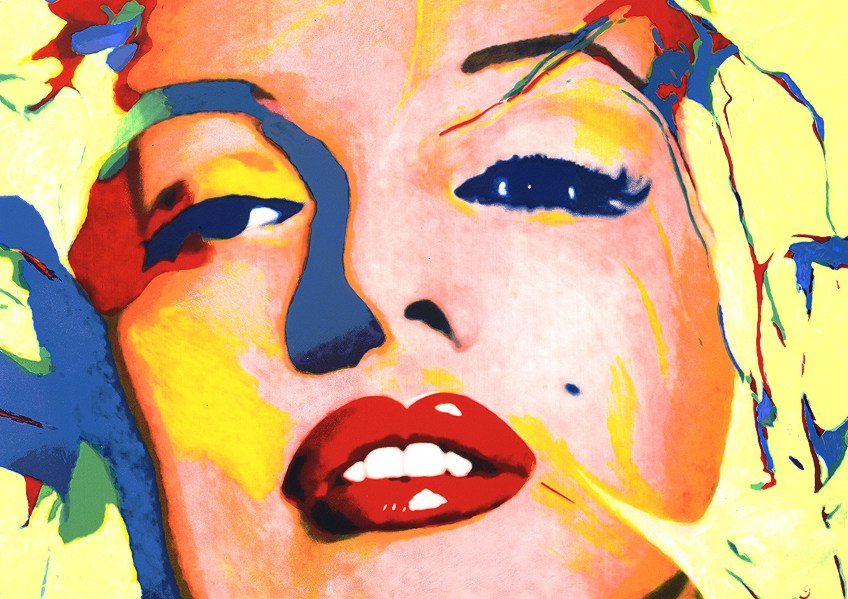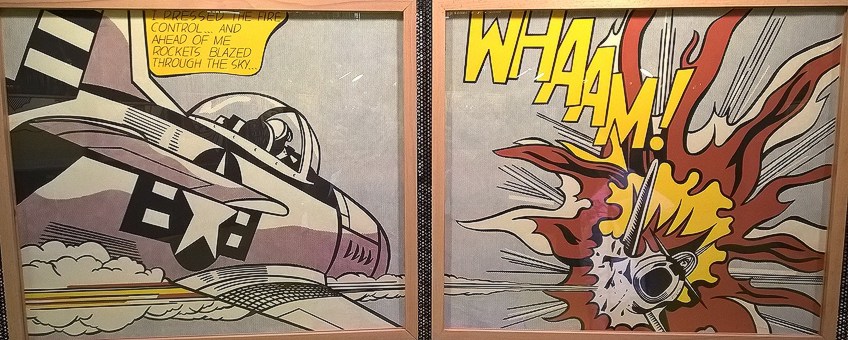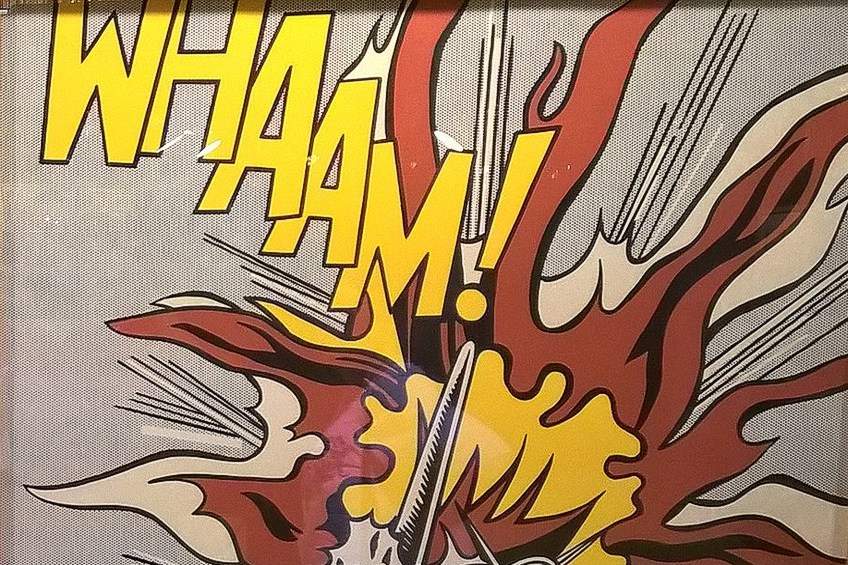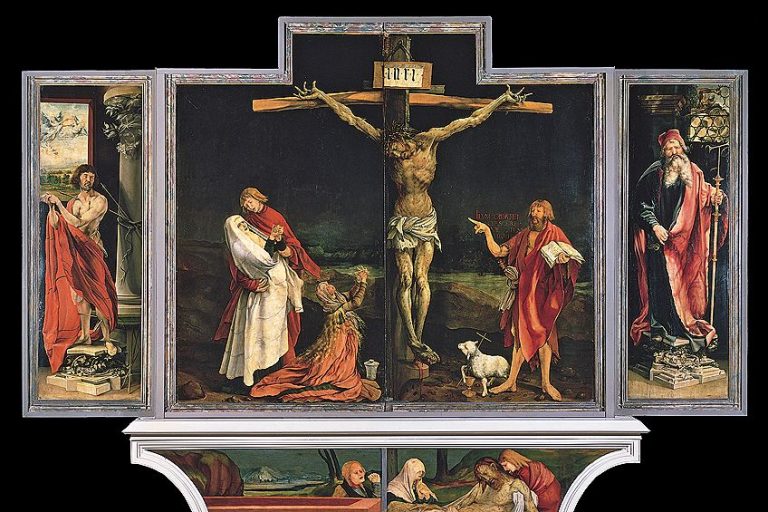Famous Pop Art Paintings – Iconic Pop Artists and Artworks
Pop art first began to emerge in the mid-1950s in both the United Kingdom as well as the United States of America. The movement was a reactionary response to the preceding Abstract Expressionism period and sought to challenge the stringent stylistic rules that were imposed upon them in fine art by incorporating images from mainstream culture and the popular consciousness. This included imagery taken from printed commercials, children’s illustrated comic books, and products designed for mass production, and the movement has produced many famous Pop art paintings and Pop art drawings that are some of the most valuable pieces of artwork in the world.
What Did the Pop Art Movement Stand For?
Emerging artists of the Pop movement were dissatisfied with the contemporary art paintings of the Abstract expressionism period of the 1950s. They felt that the art of the time only represented a small and elite view of the world, one that seemed fancifully artificial within the modern context of a world that was growing increasingly more saturated with images of commerce and branding in their daily lives.
These artists wanted to create pop art canvases that reflected the world they saw around them, and therefore created artworks that were intentionally garish and ironically kitsch.
Much emphasis was placed on the mechanical techniques employed in rendering the artworks with a multitude of mediums utilized, mixed with images that had been removed from their source material and re-contextualized in a manner that gave it new meaning. The movement shares similarities with the Dada movement in its use of repurposed images. Not only was the Pop art movement a reactionary response to the preceding Abstract Expressionism period, but it also expanded upon some of its techniques and concepts in a form of reimagined abstract pop art.

Our Top 10 Famous Pop Art Paintings
Pop a rt painting covered themes that explored the application of fine art techniques to popular images of the era, a reflection of the mundane mass design prevalent in that time. Many of these artists and their associated works are now the most valuable and renowned in the art world.
From some of the first examples of the Pop art style through to modern Pop art, let’s take a deeper look at ten famous pop art paintings and why they had such an influential impact on the art world.
Campbell’s Soup Cans by Andy Warhol (1962)
| Artist | Andy Warhol |
| Dated Painted | 1962 |
| Medium | Synthetic Polymer on Canvas |
| Dimensions | 51 cm x 41 cm |
American-born Pop artist Andy Warhol started work on Campbell’s Soup Cans in late 1961 and completed it in April of 1962. Divided into 32 canvases, each canvas had the image of a different flavor of soup available from the Campbell’s brand range printed onto the canvas using the silkscreen process. This is a prime example of the stylistic re-appropriation of popular commercial designs meant for mass production that would become a hallmark of the movement.
Campbell’s Soup Cans premiered at Warhol’s first solo exhibition at the Ferus Gallery of Los Angeles. This exhibition has been considered the debut of the Pop art movement on the West Coast of the United States of America. Warhol’s exhibition debuted in an era that was dominated by the most prominent art form of the early 1950s, Abstract Expressionism. For ardent supporters of the abstract movement, Warhol’s Campbell’s Soup Cans was seen as an insult and snubbing of the traditional philosophies.
However, while Warhol’s delivery on the surface seems to have lacked any noticeable commentary, it was designed to come across as expressionless intentionally, and he found great pleasure in seeing beauty in what others might consider mundane or commonplace.
By applying techniques derived from elitist high art, he hoped to elevate the symbols of the modern commercial era to something beyond their original intention, by taking something that was meant for the mass market and turning it into a work of art.
Whaam! by Roy Lichtenstein (1963)
| Artist | Roy Lichtenstein |
| Dated Painted | 1963 |
| Medium | Magna Acrylic and Oil on Canvas |
| Dimensions | 172 cm x 406 cm |
Whaam! is the most well-known work of art by the American Pop artist Roy Lichtenstein, and was created in 1963. Lichtenstein is recognized as the most influential and renowned Pop artist to come out of America after Warhol himself. His style is most noticeably identified by the thick black lines and colors inspired by the aesthetic of comic books of the 1950s. His artwork also incorporated the use of Ben-Day dots on his Pop art canvases, which was a printing technique used to cheaply create colors and shading in comic books.
Whaam! is one of several of Lichtenstein’s Pop art drawings that portray planes engaged in aerial combat. It was hugely inspired by the illustrations of Irv Novick, a comic book illustrator that Lichtenstein had met during his time of service in the United States army.
Serving as a parody of the common American hero ideology, the painting depicts two planes engaged in warfare, spread across two panels.

The first panel depicts a plane launching a rocket and the second right-hand panel depicts a plane exploding from the impact of the rocket. This piece is most noted for its spatial integration of the panels, as well as the vivid use of color in relationship to the narrative elements. The name of the painting is also graphically represented in the piece itself, boldly displayed on the right-hand panel.
Whaam! is not only considered one of Lichtenstein’s most celebrated contemporary art paintings, but also one of the most recognized and renowned Pop art drawings in the Pop Art Movement. In 1966 it was purchased by the Tate Gallery in London and has since gone on to be housed at the Tate Modern where it has been on permanent display since 2006.
Flag by Jasper Johns (1955)
| Artist | Jasper Johns |
| Dated Painted | 1955 |
| Medium | Encaustic, Oil Paint and Newsprint |
| Dimensions | 107 cm x 153 cm |
Jasper Johns’ work with painting, printing, and sculpture has made him one of the most notable artists in the world. His work within the Pop Art movement extended beyond the Pop style and its influence can be found in subsequent movements such as the Neo-Dada movement. His use of symbols appropriated from within commodity culture helped lay the initial groundwork for the ideology of the then-burgeoning Pop art movement. He did not indulge in the use of human figures or Pop art portraits in his work.
He is most well known for his use of flags, maps, and targets in his art, and his most well-known artwork is also considered to be one the most easily recognizable, “Flag”.
Jasper Johns was 24 years old when he held his first solo exhibition. Flag was one of the featured works at the exhibition and was created after a dream he had of the American flag. After gaining considerable success with this work of art, Johns subsequently created over 40 American flag-themed artworks.
“Flag” measures 107 cm by 153 cm and is comprised of three canvases that had been mounted onto a piece of plywood. The materials used were oil paint, caustic, and a collage of newsprint.
True to the non-political nature of his work, all cuttings from the newspaper print were intentionally chosen not to include any headlines, but rather focused on the commercial aspects of print predominant at the time. The flag only has 48 white stars as this was before other states had been added to the flag. It also depicts thirteen red and white stripes.
A Bigger Splash by David Hockney (1967)
| Artist | David Hockney |
| Dated Painted | 1967 |
| Medium | Acrylic on Canvas |
| Dimensions | 242.5 cm x 243.9 cm |
After leaving the Royal College of Art, Hockney first visited Los Angeles in 1963. He returned a year later and remained there until 1968, with a few trips back to Europe during that time. It was in 1976 that he returned to Los Angeles and decided on staying there permanently. It was here that he grew accustomed to the more laid-back lifestyle of the local people, mainly due to the always sunny climate which he wholly enjoyed in comparison to the wet British climate he was accustomed to.
Hockney noticed that almost everybody had a swimming pool in their yards in California.
It was between the years 1964 and 1971 that Hockney began to make many paintings in his swimming pool series. His constant goal throughout this process was to experiment with unique methods of trying to emulate the ever-changing surface of the water. He found the medium of acrylic paint to be better suited for depicting the bright suburban landscapes than oil paint as it dried faster.
Hockney took inspiration for A Bigger Splash from a photograph he found in a textbook about the building of swimming pools. The background however was based on a sketch he had made based on buildings found on the Californian landscape.
There are no people in the painting, but the presence of one is hinted at by the splash left on the pool’s surface. Other than that, the picture contains little more than a palm tree and a chair.
Crack is Wack by Keith Haring (1986)
| Artist | Keith Haring |
| Dated Painted | 1986 |
| Medium | Public Space Mural |
| Dimensions | 16 foot by 26 foot |
Crack is Wack is a street mural created in 1986 by Keith Haring and is an example of modern pop art, being one of the more recent contemporary art paintings on our list. He is an American Pop artist that initially moved to New York to study traditional art, but found a thriving underground movement that was emerging on the streets of New York, depicting urban themes relevant to the social issues of the period.
His Pop art drawings have been created and used as social commentary to raise awareness on issues such as Aids and drug abuse, using the inner city walls as Pop art canvases.
The mural was painted on the wall of a handball court on the corner of 128th Street and 2nd Avenue in New York City. Haring wanted to use the mural to serve as a graphic depiction warning against the dangers associated with abuse of substances such as crack cocaine, which was rife in the area. The bright red mural features the figure of a skeleton overshadowing a group of people, in his hands he holds a crack pipe and a burning dollar bill.
Above the skeleton, the words “Crack is Wack” is written in a large dotted comic style font, surrounded by a cloud.
Haring initially received no permission from authorities to create the mural but decided to create it nonetheless for what he considered a worthwhile endeavor. He thought of it as a necessary visual statement about the crack epidemic that could help deter youth from experimenting with it. It was specifically a huge problem with people in working-class communities and the destitute. It was duly put under the protection of the City Department of Parks and it still is available to view today.
Just what is it That Makes Today’s Home so Different, so Appealing? by Richard Hamilton (1956)
| Artist | Richard Hamilton |
| Dated Painted | 1956 |
| Medium | Collage |
| Dimensions | 26 cm x 25 cm |
Richard Hamilton is considered a true pioneer of the Pop art movement alongside Eduardo Paolozzi from Scotland. Art Historians note his early works as some of the first examples exhibiting aspects and techniques that would become synonymous with Pop art sensibilities. He rose to public fame due to his exhibit entitled “Man, Machine and Motion” in 1955 and the artwork discussed here, Just what is it that makes today’s homes so different, so appealing?
It was created to be a parody of the 1950s American advertising industry, showcasing Hamilton’s desire to explore the connection between the images of mainstream culture and fine arts. The artwork is a collage of images that create the feeling of a 1950s lounge with all its modern trappings.
Central to the scene is a man standing in the nude holding an oversized lollipop in his hands. It is from this image that the emerging movement would adopt its name, “Pop” art.
Just what is it that makes today’s homes so different, so appealing? is a collage of images taken mostly from American magazines. The original lounge setting was taken from an article on flooring from the magazine Ladies Home Journal. The image of the muscular man was lifted from the magazine, Tomorrow’s Man, and is the winner of Mr. L.A in 1954, Irvin “Zabo” Koszewski.
On the Balcony by Peter Blake (1957)
| Artist | Peter Blake |
| Dated Painted | 1957 |
| Medium | Oil on Canvas |
| Dimensions | 121 m x 91 m |
Along with David Hockney, Peter Blake first exhibited his work at the Young Contemporaries. Exhibition in 1961. This has led to him being dubbed the “Godfather of Pop Art” by those within the movement. He is well versed in many mediums, but most well known for his collages, which blended images of popular culture and applied techniques derived from fine art to lift the pieces to another level of meaning.
Although On the Balcony might appear to have been created in the collage style, it is completely painted. In this painting, Hockney creates a unique aesthetic by combining various other artworks from various galleries and museums alongside consumer products and several people who could represent any anonymous being one might encounter in public spaces.
The balcony theme is repeated throughout the painting, with various snapshots, photographs, and artworks depicting 32 various balcony scenes.
For example, a copy of Manet’s The Balcony can be seen in the hand of a figure situated on the left. This painting is a perfect example of Blake’s unique style of creating what could be called “Meta-pictures”, in other words, paintings within paintings and On the Balcony is not only a prime example of this technique but also one of his most well-known works, but also an enduring and iconic part of the British Pop art movement.
I was a Rich Man’s Plaything by Eduardo Paolozzi (1947)
| Artist | Eduardo Paolozzi |
| Dated Painted | 1947 |
| Medium | Collage |
| Dimensions | 35.9 cm x 23.8 cm |
I was a Rich Man’s Plaything was created by Sir Eduardo Luigi Paolozzi in 1947. Despite adopting his Italian name from his immigrant family, Paolozzi was himself born in Edinburgh, Scotland in 1924. Amongst art historians in the Pop art movement, he is considered a pioneer, exhibiting some of the earliest examples of art that exemplified the Pop art style that was yet to emerge.
I was a Rich Man’s Plaything made by cutting out images from magazines that were given to him by ex-servicemen and turned into a collage that was then mounted on a card. It is one of ten similar works from “BUNK”, Paolozzi’s collage series from the period 1947 to 1952.
It symbolized the perceived pleasures of the American way of life in a time when that very lifestyle was under threat from totalitarian forces during the period of World War II.
This work exhibits the climate of fascination with the culture of the time in America and the consumerist nature it was heading towards, as can be identified by the placement of a Coca-Cola bottle in the corner. This work of art also precedes Lichtenstein’s use of the word ‘Pop’ in cartoon font by a good number of years, making this the first example of certain iconic symbols found in the Pop art movement.
Viewed from a modern perspective, this work raises certain problematic issues regarding the sexist and violent nature of its content. Not only is it evident that the woman is portrayed as just an object of sexual desire for men, but the image of a gun pointed at a woman’s head would not bode well in today’s more politically correct social climate.
President Elect by James Rosenquist (1961)
| Artist | James Rosenquist |
| Dated Painted | 1961 |
| Medium | Oil on Masonite |
| Dimensions | 220 cm x 365 cm |
James Rosenquist is considered a highly influential figure within the Pop art community for his mix of Pop art portraits and commercial imagery. He did not use small Pop art canvases but is most well known for his massive artworks of perplexingly juxtaposed imagery lifted in large from mainstream media and commercials.
Although seemingly enigmatic and random in meaning, James Rosenquist had combined certain images of branded products, weapons, and well-known public figures in a way that subtly hinted towards his personal social views and political inclinations.
Throughout his career, he sought to dissect the emerging consumerist culture that America was inevitably heading towards, by engaging audiences to think about various political and environmental issues through his highly provocative works of art.
In President Elect, one of Rosenquist’s most celebrated Pop art portraits, he has depicted the face of John F. Kennedy surrounded by various objects of consumerist desire such as pieces of cake and a Chevrolet in yellow. His process of creating the painting consisted of initially starting with cutouts from magazines and then repainting them photo-realistically on much larger surfaces. The concept behind placing all these seemingly random images on the same canvas was linked to his fascination with the trend at the time of public figures advertising themselves.
This was during the period of presidential campaigning and he was interested in the idea that people viewed themselves as products, like the car or food surrounding him in the painting.
Marylin Diptych by Andy Warhol (1962)
| Artist | Andy Warhol |
| Dated Painted | 1962 |
| Medium | Acrylic Paint on canvas |
| Dimensions | 205.44 cm x 289.56 cm |
Although we have already covered one of Andy Warhol’s other works in this list, it would not be complete without a mention of the highly iconic “Marylin Diptych’ which is up until the present day, one of the most recognizable Pop art portraits, whether one is aware of the movement or not.
The world-famous American actress Marylin Monroe passed away in August of 1962. In tribute to her passing, Warhol made this renowned work of art which comprises 50 images of the legendary actress.
The original image was taken from a publicity shoot for the film Niagra in 1953. The fifty images are split into two sections across the canvas, with the left column being painted in vivid bright colors and the right column being left in greyscale, fading out as it reaches the end of the canvas. In a survey from 2004, it was voted the third most influential piece of modern art.
In summary, we have learned that Pop artists wanted to connect the polar extremes of high art and low art, by making the artform representative of the world around them and displaying that world reflectively back at an audience through exhibits and installations. Many of these artists have gone on to create works of art that have the highest value known in the modern art world.
Take a look at our famous Pop art webstory here!
Frequently Asked Questions
What Is Pop Art?
Pop art refers to the art movement of the 1950s and 1960s that was based on popular and commercial culture. The movement was primarily based in the United Kingdom and America, and comprised of famous artists like Andy Warhol and Roy Lichtenstein.
What Is the Most Famous Piece of Pop Art?
One of, or perhaps the most recognizable pieces of Pop art is the famous Andy Warhol’s Marilyn Diptych, which he created in 1962. The piece is painted on silkscreen and depicts 50 images of the famous actress Marilyn Munroe.
Who Is the Best Pop Art Artist?
One of the most famous Pop artists of all time is Andy Warhol, who produced iconic and instantly-recognizable artworks based on popular culture throughout the 1960s, such as Campbell’s Soup Cans.
Isabella studied at the University of Cape Town in South Africa and graduated with a Bachelor of Arts majoring in English Literature & Language and Psychology. Throughout her undergraduate years, she took Art History as an additional subject and absolutely loved it. Building on from her art history knowledge that began in high school, art has always been a particular area of fascination for her. From learning about artworks previously unknown to her, or sharpening her existing understanding of specific works, the ability to continue learning within this interesting sphere excites her greatly.
Her focal points of interest in art history encompass profiling specific artists and art movements, as it is these areas where she is able to really dig deep into the rich narrative of the art world. Additionally, she particularly enjoys exploring the different artistic styles of the 20th century, as well as the important impact that female artists have had on the development of art history.
Learn more about Isabella Meyer and the Art in Context Team.
Cite this Article
Isabella, Meyer, “Famous Pop Art Paintings – Iconic Pop Artists and Artworks.” Art in Context. November 16, 2021. URL: https://artincontext.org/famous-pop-art-paintings/
Meyer, I. (2021, 16 November). Famous Pop Art Paintings – Iconic Pop Artists and Artworks. Art in Context. https://artincontext.org/famous-pop-art-paintings/
Meyer, Isabella. “Famous Pop Art Paintings – Iconic Pop Artists and Artworks.” Art in Context, November 16, 2021. https://artincontext.org/famous-pop-art-paintings/.











